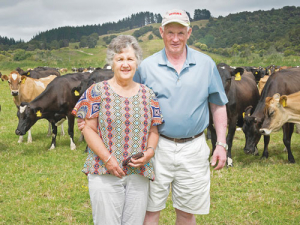Recycling 10,000 cow collars
MSD Animal Health New Zealand has partnered with Agrecovery in New Zealand’s first pilot to recycle SenseHub Dairy Collars (previously known as Allflex Collars) used by its dairy farmer clients.
 Northland dairy farmers David and Collen Fagan found the effects of economising on dry cow therapy treatments soon show up in bulk milk cell counts.
Northland dairy farmers David and Collen Fagan found the effects of economising on dry cow therapy treatments soon show up in bulk milk cell counts.
David and Colleen Fagan, of Northland, take pride in the quality of the milk their cows produce, reports MSD Animal Health NZ.
In fact, their local veterinary practice, Dargaville Veterinary Centre, recognised the Fagans’ good results recently with an award for the best overall milk quality in their area.
But it’s not by accident: any average bulk tank somatic cell count for a season that’s below 100,000 is a sign of consistently good milk quality and the couple achieved this three years in a row by carefully managing mastitis risk. In the 2013-14 season their cell counts averaged just 90,000, then 72,000 in 2014-15 (their award-winning season) and 75,000 in 2015-16.
The Fagans have run their family farm for 40 years at Hoanga, near Dargaville, with a manager and his son doing the day-to-day running. The 110ha (eff, 120 total) milks 320 cows of various breeds.
David Fagan says a tough spring set the current season off to a slow start. “We’re 12-13% down on this time last year, and that wasn’t a great year to start with.”
But by early summer, conditions were improving and production was starting to catch up.
It’s a challenging environment, frequently wet, with soils prone to pugging in winter. They had been running autumn and spring-calving herds, but have since sold the autumn herd, making management simpler.
Like most in the dairy industry, the Fagans have found the sub-$5 payouts for the past two seasons difficult and they had to take a hard look at costs, animal health included.
One strategy to achieve such high milk quality has been blanket treating their herd with Cepravin Dry Cow at drying off. The long-acting treatment cures any existing infections, helps prevent new infections during the dry period and at calving, and contributes to low somatic cell counts during the following lactation.
In 2016, the Fagans decided to cut back on dry cow therapy. They stayed with the same product, but targeted only cows with relatively high average cell counts in the 2015-16 season (250,000 or more) and those treated for clinical mastitis during the season.
Fagan says it was a calculated move and likely to have an impact on milk quality in the 2016-17 season. This season, he and his vet Joyce Gallaghan were surprised how quickly the economising showed up in the bulk tank somatic cell counts in the new season.
The number of clinical cases of mastitis is also much higher than usual for the season to date. By mid-December at least 60 cases had been treated, compared with 32 cases in the previous season. It may all have put a drag on production.
The increase in average cell counts this season has not been dramatic, however. Bulk tank cell counts have risen as high as 134,000 and are staying over 100,000 for now, but the Fagans had the luxury of starting from a good position.
Joyce Gallaghan says the experience shows that cows apparently not infected at drying off could still have been flying under the radar with low-grade mastitis that spilled over into this season.
Fagan is comfortable with the decision he made this past season, but it’s likely to be a one-off. And things are looking brighter with the current season Fonterra payout forecast at a more sustainable $6.50–$6.60.
“We’ll be going back to blanket treating the herd at the end of this season,” he says.
The National Wild Goat Hunting Competition has removed 33,418 wild goats over the past three years.
New Zealand needs a new healthcare model to address rising rates of obesity in rural communities, with the current system leaving many patients unable to access effective treatment or long-term support, warn GPs.
Southland farmers are being urged to put safety first, following a spike in tip offs about risky handling of wind-damaged trees
Third-generation Ashburton dairy farmers TJ and Mark Stewart are no strangers to adapting and evolving.
When American retail giant Cosco came to audit Open Country Dairy’s new butter plant at the Waharoa site and give the green light to supply their American stores, they allowed themselves a week for the exercise.
Fonterra chair Peter McBride says the divestment of Mainland Group is their last significant asset sale and signals the end of structural changes.

OPINION: Your old mate welcomes the proposed changes to local government but notes it drew responses that ranged from the reasonable…
OPINION: A press release from the oxygen thieves running the hot air symposium on climate change, known as COP30, grabbed your…